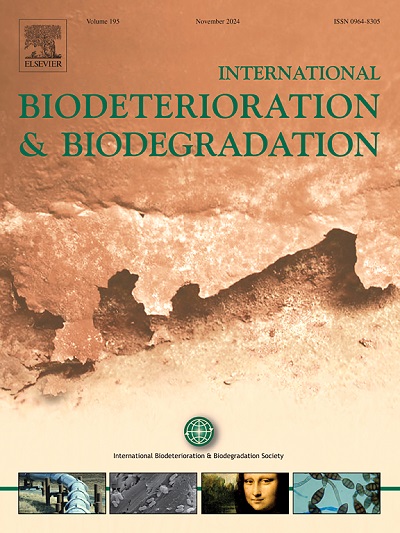Optimizing biodegradation of polychlorinated biphenyls (PCBs) using bacteria isolated from common effluent treatment plant (CETP) sludge: Integration of machine learning, kinetic studies, and metabolomic analysis
IF 4.1
2区 环境科学与生态学
Q2 BIOTECHNOLOGY & APPLIED MICROBIOLOGY
International Biodeterioration & Biodegradation
Pub Date : 2025-02-01
DOI:10.1016/j.ibiod.2024.105992
引用次数: 0
Abstract
The present study demonstrates the effective biodegradation of six polychlorinated biphenyls (PCBs) using microbial consortia consisting of Bacillus sp. and Stutzerimonas sp. Isolated from common effluent treatment plant (CETP) sludge for sustainable environmental remediation. The process during the degradation was optimized using machine learning Artificial Neural Networks (ANN) and Response Surface Methodology (RSM) with Box-Behnken Design (BBD), leading to high degradation efficiencies: 100% for PCB28 and PCB52, 98.89% for PCB101, 98.85% for PCB138, 95.89% for PCB153, and 88.56% for PCB180. The metabolites generated during the study are less toxic and nontoxic. The consortium followed two degradation pathways; acetyl CoA and Pyruvic acid. Further, the degradation kinetics studied during the process reveals that PCB138,153and 180 followed first-order kinetics, while PCB 28, 52, and 101 followed second-order kinetics. Moreover, the bacterial growth kinetics were studied using the Gompertz fitting curve with an R2 value of 0.9405. The findings underscore the importance of fine-tuning biodegradation processes to enhance their efficiency, ultimately contributing to greener, more sustainable methods for PCB remediation. By integrating machine learning and statistical optimization, this study paves the way for future advancements in environmental biotechnology aimed at mitigating the adverse impacts of PCBs on ecosystems and human health.

利用从普通污水处理厂(CETP)污泥中分离的细菌优化多氯联苯(PCBs)的生物降解:机器学习、动力学研究和代谢组学分析的集成
本研究展示了从普通污水处理厂(CETP)污泥中分离的由芽孢杆菌和Stutzerimonas sp.组成的微生物联合体对六种多氯联苯(PCBs)的有效生物降解,用于可持续的环境修复。利用机器学习人工神经网络(ANN)和响应面法(RSM)结合Box-Behnken设计(BBD)对降解过程进行优化,降解效率分别为PCB28和PCB52 100%、PCB101 98.89%、PCB138 98.85%、PCB153 95.89%和PCB180 88.56%。研究过程中产生的代谢物毒性较小,无毒。该联合体遵循两种降解途径;乙酰辅酶a和丙酮酸。此外,研究过程中的降解动力学表明,pcb138,153和180遵循一级动力学,而PCB 28, 52和101遵循二级动力学。采用R2为0.9405的Gompertz拟合曲线对细菌生长动力学进行了研究。这些发现强调了微调生物降解过程以提高其效率的重要性,最终有助于更环保、更可持续的PCB修复方法。通过整合机器学习和统计优化,本研究为未来环境生物技术的发展铺平了道路,旨在减轻多氯联苯对生态系统和人类健康的不利影响。
本文章由计算机程序翻译,如有差异,请以英文原文为准。
求助全文
约1分钟内获得全文
求助全文
来源期刊
CiteScore
9.60
自引率
10.40%
发文量
107
审稿时长
21 days
期刊介绍:
International Biodeterioration and Biodegradation publishes original research papers and reviews on the biological causes of deterioration or degradation.

 求助内容:
求助内容: 应助结果提醒方式:
应助结果提醒方式:


